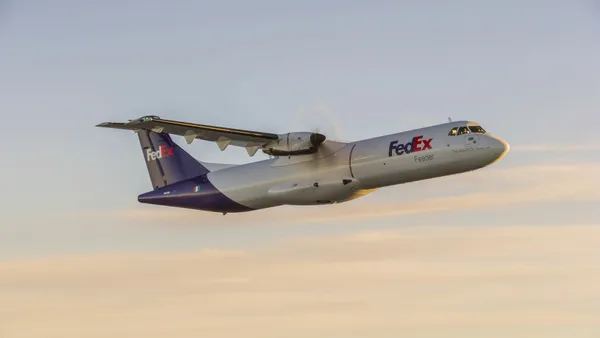Dive Brief:
- Airfreight volume fell 8% YoY in September, according to the latest numbers from the International Air Transport Association. But the industry continues to show improvement over its April trough and grew nearly 4% compared to August, which is the fastest pace since May, according to IATA.
- Freighter capacity has "increased significantly" in recent months, but overall global airfreight capacity is still down more than 25% YoY due to the continued lack of belly space, IATA said. But the "preighter" fleet is growing with an estimated 2,500 passenger planes converted to carry cargo in their cabins.
- "Favorable indicators for the peak year-end season will support the continued recovery in demand," IATA CEO Alexandre de Juniac said in a statement. "The challenge continues to be on capacity. As carriers adjust schedules to reflect falling passenger demand amid the resurgence of COVID-19, valuable belly capacity will be lost when it is needed the most."
Dive Insight:
The demand for air cargo is expected to improve even more at the tail end of 2020. The level of the new export orders in the Global Manufacturing PMI rose above 50 in September for the first time since the middle of 2018, a sign of strong demand for freight to move those exports. Meanwhile, holidays are approaching along with highly anticipated electronics releases like the iPhone and PlayStation 5 that traditionally travel via air cargo, according to IATA.
And as demand improves, companies in the airfreight business continue to see booming business, thanks to the lack of belly capacity. Atlas Air saw its revenue jump nearly 25% YoY, according to its Q3 earnings release.
Atlas executives said the company has added capacity to its network to meet this demand, and shippers' interest in forming more long-standing relationships has increased.
"Long-term charter contracts ... go up to three years in length," Atlas Air Chief Financial Officer Spencer Schwartz said on the company's earnings call. "And so, we’re starting to use a lot of our capacity with these longer-term arrangements, which is great from a predictable, reliable nature of our revenue and our earnings streams, and they’re really good contracts."
Schwartz later added that all of Atlas' "customers are looking to add capacity right now."
The increased demand for airfreight heading into the holiday season has led rates to spike again. Rates between China/Hong Kong and the United States have increased by nearly 46% between Oct. 12 and Nov. 9 to reach $7.40 per kilogram, which is more than double the rate during the same time last year. Atlas executives said rates will likely not hit the same highs as earlier in the pandemic.
"We don’t expect rates to reach ... the levels we saw in the second quarter," Schwartz said. "Especially, April and early May." Atlas still has the capacity "to serve the ad hoc spot market," he added.
Airlines traditionally associated with the passenger market have also added cargo capacity.
"We more than doubled our cargo only flying from August to September and operating more than 1,900 flights, serving 32 destinations during the third quarter," American Airlines President Robert Isom said last month.














